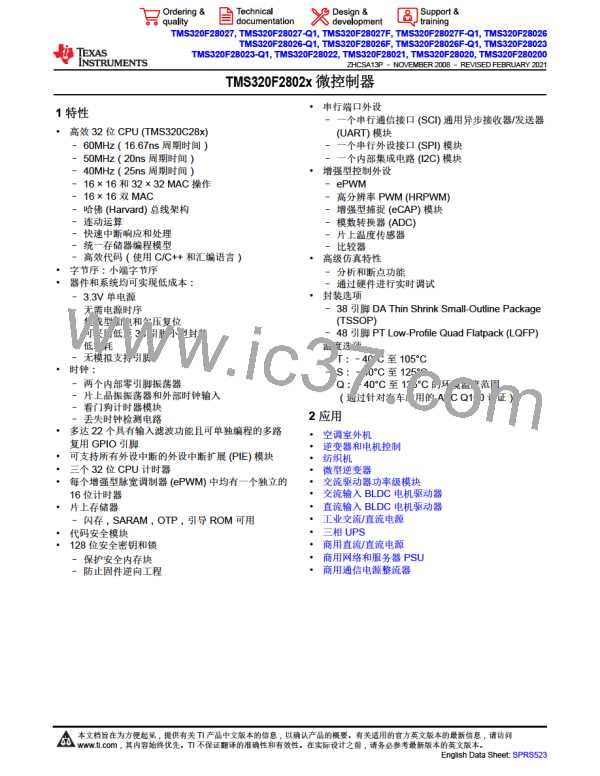TMS320F28027, TMS320F28027-Q1, TMS320F28027F, TMS320F28027F-Q1, TMS320F28026
TMS320F28026-Q1, TMS320F28026F, TMS320F28026F-Q1, TMS320F28023
TMS320F28023-Q1, TMS320F28022, TMS320F28021, TMS320F28020, TMS320F280200
ZHCSA13P –NOVEMBER 2008 –REVISED FEBRUARY 2021
www.ti.com.cn
9.1.9 Security
The devices support high levels of security to protect the user firmware from being reverse engineered. The
security features a 128-bit password (hardcoded for 16 wait states), which the user programs into the flash. One
code security module (CSM) is used to protect the flash/OTP and the L0/L1 SARAM blocks. The security feature
prevents unauthorized users from examining the memory contents through the JTAG port or trying to boot-load
some undesirable software that would export the secure memory contents. To enable access to the secure
blocks, the user must write the correct 128-bit KEY value that matches the value stored in the password
locations within the Flash.
In addition to the CSM, the emulation code security logic (ECSL) has been implemented to prevent unauthorized
users from stepping through secure code. Any code or data access to flash, user OTP, or L0 memory while the
JTAG debug probe is connected will trip the ECSL and break the debug probe connection. To allow debug of
secure code, while maintaining the CSM protection against secure memory reads, the user must write the
correct value into the lower 64 bits of the KEY register (KEY0 - KEY3), which matches the value stored in the
lower 64 bits of the password locations (PWL0 - PWL3) within the flash. Dummy reads of all 128 bits of the
password in the flash must still be performed. If the lower 64 bits of the password locations are all ones
(unprogrammed), then the KEY value does not need to match. During debug of secure code, operations like
single-stepping is possible. However, the actual contents of the secure memory cannot be seen in the CCS
window.
When power is applied to a secure device that is connected to a JTAG debug probe, the CPU will start executing
and may execute an instruction that performs an access to a protected area. If this happens, the ECSL will trip
and cause the JTAG circuitry to be deactivated. Under this condition, a host (such as a computer running CCS or
flash programing software) would not be able to establish connection with the device.
The solution is to use the Wait boot option. In this mode, the device loops around a software breakpoint to allow
a JTAG debug probe to be connected without tripping security. The user can then exit this mode once the JTAG
debug probe is connected by using one of the emulation boot options as described in the Boot ROM chapter in
the TMS320F2802x,TMS320F2802xx Technical Reference Manual. These devices do not support a hardware
wait-in-reset mode.
备注
• When the code-security passwords are programmed, all addresses from 0x3F7F80 to 0x3F7FF5
cannot be used as program code or data. These locations must be programmed to 0x0000.
• If reprogramming of a secure device via JTAG may be needed in future, it is important to design
the board in such a way that the device could be put in Wait boot mode upon power-up (when
reprogramming is warranted). Otherwise, ECSL may deactivate the JTAG circuitry and prevent
connection to the device, as mentioned earlier. If reconfiguring the device for Wait boot mode in the
field is not practical, some mechanism must be implemented in the firmware to detect when a
firmware update is warranted. Code could then branch to the desired bootloader in the bootROM. It
could also branch to the Wait bootmode, at which point the JTAG debug probe could be connected,
device unsecured and programming accomplished through JTAG itself.
• If the code security feature is not used, addresses 0x3F7F80 to 0x3F7FEF may be used for code
or data. Addresses 0x3F7FF0 to 0x3F7FF5 are reserved for data and should not contain program
code.
The 128-bit password (at 0x3F 7FF8 to 0x3F 7FFF) must not be programmed to zeros. Doing so
would permanently lock the device.
Copyright © 2022 Texas Instruments Incorporated
Submit Document Feedback
39
Product Folder Links: TMS320F28027 TMS320F28027-Q1 TMS320F28027F TMS320F28027F-Q1
TMS320F28026 TMS320F28026-Q1 TMS320F28026F TMS320F28026F-Q1 TMS320F28023 TMS320F28023-
Q1 TMS320F28022 TMS320F28021 TMS320F28020 TMS320F280200

 TI [ TEXAS INSTRUMENTS ]
TI [ TEXAS INSTRUMENTS ]